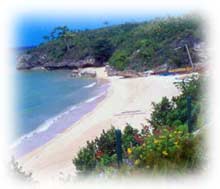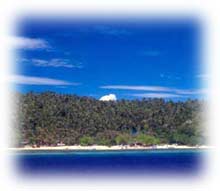
|
NextGen Day - Philippine Travel - Mindoro Guide and Travel Information |
|
ORIENTAL MINDORO TRAVEL INFORMATIONWhere to Stay in Oriental Mindoro
| Description | History Oriental Mindoro - The Islands' Loveliest Harbor The inverted-J-shaped Oriental Mindoro is endowed with some of the Philippine Islands’ best naturescapes. Choose your own beach among the many that abound, from fawn beige to powdery white. Then match the experience with interesting mountain lairs, lakes, rivers, rain forests, wild animals, rare flora and fauna, and pocket communities of the existing ethnic groups. It has maintained its unspoiled environment, all within a rustic agricultural setting.
Alibatan Island in Baco, noted for its white sand, serves as a breeding place for seagulls and turtles. Corals and oysters can be found all around the area. Also in Baco is Mt. Halcon, the country's third highest peak and a favorite destination for nature tripping and mountain climbing. In Puerto Galera, 423-foot Tamaraw Falls is a series of asymmetrical falls, leading to a grand fall, dropping to the frothy waterbed below. Another attraction within the area is Sabang Beach, a portion of which is tourist-flocked for water sports and a cluster of nightspots popular for evening socials. Beside Sabang Beach is Small La Laguna, with amazingly beautiful coral reefs, and water ideal for snorkeling and scuba diving. Indulge in a number of special interest tours while in the province, from mountain climbing to trekking, hiking, camping, butterfly watching, game fishing, and adventure trips to the wilderness. Enjoy active water sports such as scuba diving, snorkeling, and swimming. Visit the Mangyan settlement areas, and find it rewarding to engage in natural cave and waterfall exploration and island hopping." GEOGRAPHY
It has a total land area of 436,470 hectares. The province has 39 named and 89 unnamed islands and islets, leaving much of its attractions virgin to visitors, and an untrammeled area to explore. CLIMATE Oriental Mindoro enjoys a climate favorable to vegetable growth throughout the year. What is remarkable is that there is neither a dry season nor a pronounced maximum rain period. The location and topography of the island on the western side of the great ocean body is another contributing factor in the rainfall pattern of the province. China Sea, fed by warm water from a branch of south equatorial current, passes between Singapore and Borneo thus keeping the water bodies surrounding the island warm year-round and consequently providing excellent sources of moisture. POPULATION Based on the May 2001 National Statistics Survey, Oriental Mindoro Island registered a total population of 669,000. The people are mostly of Tagalog stock. The ethnic Mangyan tribe consists of various smaller tribes like the Iraya, Alangan, and Tadwanan. INDUSTRIES The lifestyles of Mindoreños are basically simple and rural. 70 percent of the populace engage in land and sea agriculture, with only 30 percent living in urbanized centers. The ethnic tribes, Mangyans, are gentle and withdrawn but many of them have managed to integrate into the cultural mainstream, largely in the municipalities of Mansalay, Baco, Puerto Galera, Roxas, and Bongabong. These Mangyans are skilled weavers and craftsmen, producing intricate tribal finery, including baskets, mats, and other items, both functional and aesthetic. LANGUAGE / DIALECTS Visiting Oriental Mindoro does not entail memorizing bits of conventional lines in dialects spoken other than Tagalog, which serves as the predominant dialect. Other dialects spoken are Ilocano and Cebuano. Strains of the Mangyan dialect spoken are Arayan, Alagnan, Buhid, Hunuo, and Tadyawan. The working population can read and speak Filipino and English. POLITICAL SUBDIVISION Oriental Mindoro is composed of 15 municipalities, with Calapan City as the capital of the province. The municipalities are Baco, Bansud, Bongabong, Bulalacao, Naujan, Mansalay, Pinamalayan, Pola, Puerto Galera, Roxas, San Teodoro, Socorro, and Victoria Gloria. Oriental Mindoro History... In the early years of Spanish rule, Mindoro was administered as a part of the province of Batangas, then known as Bonbon. It was separated from Batangas, with Puerto Galera as its capital, during the 17th century. In 1902, the island of Lubang was annexed to Mindoro, which gained full provincehood in 1921. In 1950, the island was divided into two separate and autonomous provinces through Republic Act No.505, designating the eastern portion of the island as Oriental Mindoro, with Calapan as its capital, and the western part as Occidental Mindoro, with Mamburao as its capital. Every November 15, the people celebrate the Sanduguan Festival. It is a re-enactment of the first historical trade and cultural contact between the natives of the island of MA-l (Mindoro) and traders from China. Sanduguan is derived from the native word ""Sandugo,"" which literally means ""blood brother."" The festival is done in consonance with the founding anniversary of Mindoro Oriental. Oriental Mindoro Is Famous For... Puerto Galera. Mangyan Tribes. Mt. Halcon. Tamaraw Falls. Beaches. Sabang Beach. Banana Festival Oriental Mindoro Trekking Where to Stay in Oriental Mindoro
| Description | History |
Philippine Infrastructure - Philippine Sports & Recreations - Philippine Travel Tips
Getting Around to the Philippines - Philippine Map
People of the Philippines - Culture and Arts - Philippine Religion - Philippine Churches
Philippine Food & Cuisine - Philippine Festivals and Events - Philippine Beaches
Philippine Dive - Philippine Wildlife - Philippine Heritage Sites - Philippine Golf - Philippine Popular Activities
NextGen Day
Hotels | Cruises | Flights | Travel Agents | Tour Operators | Travel and Leisure
Travel Incentive Program / Travel Articles / Travel Recreation & Activities
Travel Updates / Health Tourism / Real Estate Tourism
NextGen Day : Australia, Asia Travel, Africa Travel, Europe Travel, Middle East Travel, USA Travel
 The
province's foremost asset is Puerto Galera, blessed with one of the
world’s most beautiful natural harbors. Known as the Pearl of Mindoro,
it is world-famous for splendid beaches, coral reefs, and exquisite
dive sites for new and experienced divers alike. There are shallow coral
gardens, interesting rock formations, and colorful species to watch,
like crabs, shrimps, sea anemones, moray, and trumpet fishes.
The
province's foremost asset is Puerto Galera, blessed with one of the
world’s most beautiful natural harbors. Known as the Pearl of Mindoro,
it is world-famous for splendid beaches, coral reefs, and exquisite
dive sites for new and experienced divers alike. There are shallow coral
gardens, interesting rock formations, and colorful species to watch,
like crabs, shrimps, sea anemones, moray, and trumpet fishes. Oriental
Mindoro is located 15 kilometers off the southwest coast of Luzon. It
lies on the eastern portion of the island. It is bounded on the north
by Verde Island and the Verde Passage, on the east by Maestro de Campo
Island and Tablas Strait, on the south by Semirara Island near Pandarodan
bay, and on the west by the province of Occidental Mindoro.
Oriental
Mindoro is located 15 kilometers off the southwest coast of Luzon. It
lies on the eastern portion of the island. It is bounded on the north
by Verde Island and the Verde Passage, on the east by Maestro de Campo
Island and Tablas Strait, on the south by Semirara Island near Pandarodan
bay, and on the west by the province of Occidental Mindoro.